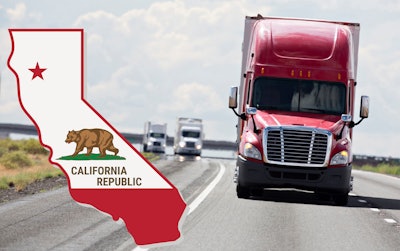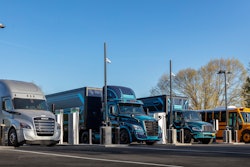
Editor's note: This article was amended on Jan. 3, 2024, with new information provided by California's Air Resources Board.
Affinity Truck Center will have a great sales year in 2023, President Kim Mesfin says. The Volvo and Mack dealer based in California’s central valley is on pace to approach an all-time record for Class 8 truck deliveries.
But this month, instead of preparing for a historically great sales jump in 2024, Affinity is bracing for a market crash and strategizing how it will survive.
In California, the company’s doomsday outlook isn’t an isolated one. Due to new regulations by California’s Air Resources Board (CARB) set to go into effect Jan. 1, all truck dealers in California are teetering on the brink of disaster.
Unless CARB reverses course, and fast, the days of buying a diesel truck in California might be over a lot earlier than 2036.
Impending regulatory burden
“Once existing stock is delivered, we are staring at a reality where when January hits we’re not going to have diesel trucks we can sell,” says Mesfin, who in addition to leading Affinity also serves as Volvo’s line rep with the American Truck Dealers (ATD) and is Chair for the California Truck Dealers (CTD).
Mesfin says the looming cliff event is being created by CARB’s Advanced Clean Trucks, Advanced Clean Fleets and, most specifically, its new Omnibus NOx emissions rule. Though the first regulation is directly tied to OEM zero-emission vehicle (ZEV) sales requirements, the latter two are proving more destructive for California’s 153 commercial new truck dealers.
ACF will require fleet operators of a certain size or application to purchase ZEVs when buying new trucks in 2024 and beyond. The Omnibus NOx rule will lower the NOx emissions standard for 2024 model year internal combustion engines (ICE) sold in California to 0.050 g/bhp-hr, though CARB does state it offers several flexibilities for vehicles sold to transit agencies and that meet other horsepower thresholds.
Those technological advancement have proven difficult to achieve and scale.
CARB reported to Trucks, Parts, Service on Jan. 3, 2024, that OEMs will be allowed to use model year 2023 engines in their production lines through March 31, 2024, to allow for new equipment to continue entering the state. CARB also reported 17 truck engines have achieved certification from the state to be sold under the regulation, including Class 8 engines from three manufacturers, yet as of publication of this story none of those manufacturers have brought their Omnibus-compliant engine into production and the market.
This is expectedly crippling for OEMs and dealer revenue streams and is forcing the former to drastically reduce order allotments for the latter. CARB and the Truck and Engine Manufacturers Association (EMA) negotiated a Clean Truck Partnership in July, which enables OEMs to apply credits previously acquired to sell some legacy ICE tractors through their dealer channel in 2024. In conversations with other dealers across the state, Mesfin says the trio of regulations could cut the total sale of new Class 8 trucks in California by up to 90% in 2024.
“CARB has accidently reduced the availability of diesel trucks so far so fast that we’re going to be cut out of the market,” she says. “This NOx regulation is trying to regulate the last 2% of emissions from these engines, but it’s too far, too fast. What I’ve been hoping is they would push things out [delaying implementation of the regulation] to EPA 2027, so the OEMs would have a chance to get there, and the nation would stay aligned.”
Compliant engine rollout delays
OEMs are racing to meet the regulation as best as they can. Representatives from Kenworth and Volvo speaking at November’s Used Truck Association Convention said engineers have devised a method to achieve the Omnibus NOx minimum but did not give a timeline for the California rollout of the new equipment. They did note the advanced technology will add up to $25,000 to the cost of a new Class 8 tractor.
At the American Trucking Associations’ (ATA) Management Conference & Exhibition in October, Daimler Trucks North America (DTNA) Vice President of Product Compliance & Regulatory Affairs Sean Waters said DTNA’s brands Freightliner and Western Star will have a variety of diesel engine platforms available in the state next year, but all at limited quantities.
[RELATED: Trucking is pondering a future without the diesel engine. Why?]
California Truck Centers President Doug Howard has eight locations across the state representing DTNA’s truck brands. Like Mesfin, Howard says his dealerships will be receiving a limited amount of diesel engines to sell in the state and is unsure of when that allocation will end.
But Howard says his largest concern today is how customers will take ownership of the trucks they’ve already ordered and the dealership intends to deliver.
“We have a large portion of customers who are engaged in interstate commerce,” he says. “Initially, we were told those customers could buy non-California compliant engines because they will be titling them and using them elsewhere, but just in the last two weeks we’ve learned that those trucks cannot even enter the state of California to come to a dealership. Even if they’re going to be titled and sold into another state.”
Howard says his team is now scrambling to find DTNA dealers in other states who can prep those trucks for delivery to their customers so the orders don’t have to be canceled.
“CARB says those trucks cannot enter the state until they are titled and licensed,” he says.
Other engine makers are facing the same challenges.
Cummins, responding to TPS sister publication CCJ about a rumor regarding availability of its popular X15 engine in California next year, attempted to quell the rumor but did not ensure carriers that the engine would be available without order restrictions.
“Cummins and others in the industry have worked transparently with CARB to be able to provide solutions to the California market in 2024,” the company told CCJ. “These discussions resulted in various provisions that allow Cummins to provide our entire diesel portfolio at volumes that support the market demand. While Cummins will have restrictions on diesel product available specifically in California, the limits reported in the blog are not accurate.”
But Mesfin says allocation reductions are going to happen.
Dealers across the state representing all brands are seeing substantial decreases in allotment relative to demand, she says, and some OEMs have bluntly told dealers they will not have Class 8 diesel tractors to sell next year if these regulations are implemented as planned.
Additionally, in response to questions from TPS regarding the Omnibus regulation, CARB stated last week it “engaged with truck manufacturers throughout the development of the Omnibus Regulation, and has continued to engage with those manufacturers after the Omnibus Regulation was adopted,” in reference to the Clean Truck Partnership.
CARB added, “As detailed in that agreement, truck manufacturers commit to comply with the requirements of the Omnibus regulation as they existed on Dec. 22, 2021, and as those requirements are modified by subsequent specified amendments to the Omnibus regulation, and also commit not to challenge CARB’s issuance of the Omnibus regulation or challenge any EPA waiver issued for the Omnibus regulation.”
Industry frustration mounting
Yet the tenuous partnership between regulators and manufacturers hasn’t reduced stress for customers.
[RELATED: How to effectively sell alternative power]
In a speech to members of European Parliament in October, ATA President and CEO Chris Spear was adamant that California’s “patchwork of conflicting regulations is not ideal nor conducive in achieving zero emissions. California’s ‘go it alone’ strategy will result in capped diesel sales, an extension of older and higher polluting trucks on the road, and significant price increases in the dwindling number of available diesel trucks. This framework has set California up for failure, which in turn sets our industry and economy up for failure.”
Carriers feel the same.
“I believe more effort should be going to designing better equipment that we can continue to use,” says Mark Woods, president at Wildwood Express, a 60-truck fleet in the central valley.
For decades, Wildwood has been a leading advocate for reducing truck and trailer weights to improve freight efficiency and fuel economy. Woods has advocated for the adoption of lightweight technologies and continued advancements in ICE technology to reduce emissions and believes CARB’s commitment to ZEVs will ultimately only slow that progress.
“If I’m a driver and I have to wait an hour at a packing plant to pick up load of strawberries that’s already been sold and then get it to New York in two days or whatever timeline I’ve been given, I can’t do that in an electric truck,” he says. “I can’t charge it at the packing plant because they don’t have any charging infrastructure, and then when I leave where am I going to charge it along the way?”
Mesfin has the same charging concern. The huge price disparity between a Class 8 diesel and electric tractor can be somewhat reduced through purchase vouchers, grants and incentives, but charging limitations remain. And both the ACT and ACF mandates are built around an aggressive ramp up of ZEV adoption beginning in three weeks.
ZEVs not a realistic option in 2024
At Affinity, Mesfin signed a contract for two heavy-duty chargers in September 2021 that not only have not been installed but are now delayed into late 2024. Her utility provider PG&E told her the chargers will max out grid capacity in the area when operational, blocking other dealers or customers from making the same investment for several years.
“If you call [Southern California Edison] or PG&E today and say you want to buy some BEVs and need to put in charging, you’re looking at 24- to 36-month lead time just to get electricity on your property,” Howard adds.
That infrastructure delay will cost dealers too. California does not require customers to take ownership of a ZEV until they have secured charging, which means dealers selling diesel trucks in conjunction with ZEVs will not receive payment on the equipment until the ZEV is delivered.
“Then I have a $400,000 truck sitting on my lot with 7% interest on it for who knows how long,” Mesfin says.
A Class 8 ZEV also lacks the functionality of its ICE equivalent, notes Woods, due to excessive weight and limited model configurations. Even in a perfect world where charging is ubiquitous, a battery electric Class 8 tractor with trailer cannot haul as much freight as a diesel because the batteries make the unit much heavier.
“How can I spend $400,000 to $450,000 for an electric truck instead of $160,000 for a new diesel, and then expect to charge the customer the same rate while being able to haul 25% less freight?” asks Woods. “It doesn’t make sense.”
“We have too many truck configurations that do not exist for customers as a zero-emission vehicle,” adds Mike Betts, chairman and CEO at Betts Company. “I don’t understand how we can force customers to buy these trucks when they aren’t the right fit for their application and they may not be able to charge them.”
[RELATED: How electric trucks may transform dealer revenue streams]
And while CARB says early ZEV sales are two years ahead of schedule, total unit movement remains low. Mesfin has delivered just three ZEVs to date. Nationwide, she says ZEVs accounted for 175 of 330,000 heavy-duty trucks sold in the United States last year (0.05% of sales).
“I’m for electrification. I believe this technology makes sense and will work in some applications, but this is just too far, too fast,” she says.
CARB also reported to TPS in January 2024 that the state received 1,051 truck vouchers for all ZEV truck types from January through October 2023 through its HVIP program, with 420 for Class 8 trucks.
Regulatory implementation fears mounting
Yet with January looming, CARB has yet to announce any plans to delay or amend its trio of regulations to enable truck and engine manufacturers time to meet its proposed standards. Mesfin says state regulators do not appear to realize the impact moving forward will have — not just on truck dealers and their customers, but all industries that rely on trucking for the shipment of goods.
“I don’t think CARB realizes a truck is not plug and play,” she says. “They don’t seem to realize that there isn’t just one truck that fits into their regulations and can do everything our customers [in California] need it to do.”
“We’re going to push business out of state,” Howard says. “Customers who can license their trucks in Arizona or Nevada or some other state are going to do that. They’re not going to buy trucks here because they won’t want to deal with this.”
And actions like that will be acutely devastating for California dealers, and the state’s carriers who are not operating across state lines.
“I’m worried for customers,” adds Woods. “You don’t see people driving ’55 Chevy’s around anymore, but if this happens that’s what is going to happen to us. We’re going to have to keep running the same equipment and it’s going to break down. It’s going to need more repairs and that’s going to impact everyone.”
Betts agrees. “Doing this isn’t going to bring in new trucks. It’s just going to make everyone keep running what they have.”
Woods says that’s what he’s planning. Wildwood has a typical trade cycle of six to seven years, but until CARB-approved model year 2024 or later diesel engine is available in California, he intends to hold on to what he has. “I’m not going to get rid of anything.”
Mesfin says that’s what she’s trying to convey to state regulators and leaders. In addition to constant communication with her fellow dealers, Mesfin has spoken with state regulators on behalf of the California Truck Dealers and has helped to send letters to Gov. Gavin Newsom. Sometimes the messaging falls on deaf ears, sometimes it doesn’t. The latter is sometimes worse.
“I had one person at CARB tell me ‘Why don’t we just rent a building in Nevada and sell from there?’” she says. “They don’t realize how bad this could become.”
Howard feels the same way.
“It would be one thing if we could take in the truck and then sell it to the customer who will use it out of state, but they’ve taken that away from us,” he says. “I don’t think [CARB] realizes how many people will be affected.”
The math gets ugly fast. ATD data indicates there were 9,184 commercial truck dealership employees at 153 locations in 2022. Total sales across those locations were approximately $8 billion, with 33,368 new Class 4-8 trucks being registered that year.
A 90% drop in new truck sales would detonate the entire market.
“The industry is in a really bad place right now. There are so many people leaving the industry and so many more that will have to leave the industry,” Mesfin says. “I’m going to up my base pay and keep my salespeople as long as I can. I will not lay off anyone until I have no other option. But I don’t know what other dealers will do.”
And even though CARB has a history of calling off impractical regulations at the 11th hour — “there’s a history of everything they’ve ever written being pushed out,” Mesfin says — as of today the industry needs to operate as if the regulations will come to pass.
“There is so much chaos right now and it’s hard to know what to do. I talk to dealers and everyone is waiting and hoping it gets pushed back,” Mesfin says.
Adds Howard, “I think they will be forced to make a correction. But with the lawsuits and other things going on, nothing will probably happen until the second quarter or later next year.”











